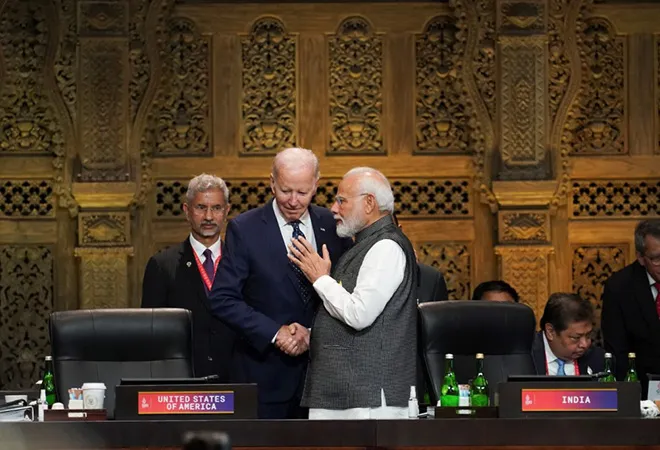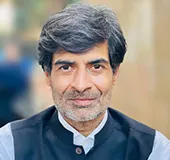The growing partnership between India and the United States has the potential to shape both the global technology landscape and 21st-century geopolitics. The two democracies must ensure that technological advances work toward a more secure and prosperous world. There is already momentum: The U.S.-India initiative on Critical and Emerging Technologies (iCET),
announced last year,
made strides to strengthen the connections between the U.S. and Indian innovation ecosystems in January. As Indian Prime Minister Narendra Modi meets U.S. President Joe Biden in Washington
this month, now is the moment to aim even higher.
Modi and Biden should convene a strategic technology partnership that cements high-level support for deepening cooperation in both the public and private sectors on innovation between India and the United States. That demands enhancing people-to-people connections, collaborating on expanding secure technology infrastructure around the world, developing standards of governance for new technologies, and engaging jointly with the global south on a democratic vision for the future.
Today, the shape of that future looks uncertain, and techno-authoritarians are on the march. It will take the collective strength of the democracies anchoring the Indo-Pacific region to chart a different course. To do so, they must unleash market forces that align with their strategic objectives. India and the United States need to sensitize investors, target large pools of available capital, and ensure that their ambitions never lack investments. India and the United States can together ensure tech opportunities are made broadly accessible.
Modi and Biden should convene a strategic technology partnership that cements high-level support for deepening cooperation in both the public and private sectors on innovation between India and the United States.
Amid growing technology competition, the United States remains a leader while India has leapt forward as an innovation powerhouse. Both countries have robust, educated workforces: The United States
leads in producing Ph.Ds. in science and engineering, while India is ahead in terms of graduates with bachelor’s degrees in those subjects. India’s entrepreneurial environment is also blossoming. In 2021, the number of
Indian unicorns—start-ups valued at more than $1 billion—increased from 40 to 108. The same year, Indian
deep tech ventures—those that portend a large impact but require significant time and capital to reach markets—raised around
$2.65 billion. In domains such as the commercial space sector, India is becoming a key
global player. New Delhi is a capable partner for Washington in the entire innovation chain, from research and development to production.
Both countries recognize the opportunity presented by emerging technologies and seem willing to work together to seize it. In February, the Modi government
announced that investments in new technologies, particularly in digital infrastructure, will underpin India’s path to become a developed nation by 2047. And in the United States, public and private sector interests are converging on a tech-focused approach to the future, starting with the
CHIPS and Science Act. The countries have cooperated on
smart city planning and
defense technology transfers. On the latter, their defense technology partnership appears poised for significant elevation, given
reports that the United States will allow General Electric to produce military jet engines—one of Washington’s most closely guarded secrets—in India.
A strategic partnership between India and the United States, focused on technology, will further the countries’ shared talent advantage. The two workforces are already interwoven, especially in the technology sector. In 2021, Indians accounted for
74 percent of all of U.S. H1-B visa allotments, and Indian employees have spurred innovation at many U.S. tech firms—to say nothing of the Indian Americans
leading two of the largest companies in the world. A strategic partnership could focus on identifying opportunities and removing hurdles for people-to-people flows.
A first order of business for such a partnership could be to address the U.S. visa backlogs for
Indian applicants, both workers and visitors. Creating programs to strengthen investor and entrepreneurial relationships between India and the United States should be another priority; doing so would deepen connections between private enterprises. The education technology sector offers promising opportunities in this regard. As U.S. edtech firms
seek to gain a greater share of the Indian online learning market, India’s edtech firms are increasingly
going global and entrenching themselves in the U.S. market and elsewhere. India and the United States should tap into this environment of constructive competition and collaboration.
As U.S. edtech firms seek to gain a greater share of the Indian online learning market, India’s edtech firms are increasingly going global and entrenching themselves in the U.S. market and elsewhere.
Next, a strategic technology partnership would invest in expanding the global infrastructure to support the digital world, particularly in the global south. Collaboration in this sphere could run the gamut: joint research and testing on beneficial disruptive technologies, manufacturing hardware, and even pooling funds for large-scale investments. India and the United States must also work together with their partners to highlight that in a world of increasing geopolitical, health, and climate risks, resilient supply chains will be an essential element of cooperation going forward. This year, India’s G-20 presidency offers a platform to further this discussion; green development, inclusive growth, and technological transformation are at the heart of New Delhi’s G-20 agenda.
India and the United States each bring a necessary piece of digital infrastructure to the table. For its part, India is a leader in
testing Open-Radio Access Networks (O-RAN) as a pathway to 5G coverage. U.S. policymakers are
enthusiastic about O-RAN as an alternative to traditional network models, where Chinese multinational Huawei has
emerged as a leading global player. And as
growing U.S. private sector interest in India as a manufacturing location illustrates, the potential to build a supply chain ecosystem with India as a hub is increasingly plausible. Following the recent India-U.S. Commercial Dialogue, the two countries
signed a memorandum of understanding to set up a semiconductor supply chain and innovation partnership, which aims to promote supply chain resilience and diversification.
A strategic technology partnership between India and the United States should also prioritize developing the standards and principles that govern the technologies of the future. Defining such standards is critical in lowering the costs and barriers for Indian and U.S. tech companies to counter competitors operating from authoritarian states. The two countries will need to work with standards-setting bodies to define how they want emerging technologies to operate in the interests of democracies. Here, the iCET is already taking
important steps on academic and industry collaboration. A strategic partnership could build on these efforts and coordinate further resources toward new private sector collaborations.
The two countries will need to work with standards-setting bodies to define how they want emerging technologies to operate in the interests of democracies.
India and the United States must also work together to mitigate the challenges of emerging technologies. Technology cannot be divorced from its implications for human rights, national security, and information ecosystems necessary for functional democracy. This will be vital in 2024, when both India and the United States hold elections. Standards must hold actors to democratic norms (and constitutional laws). As the reach of digital authoritarianism
grows, it is more important that networks are hosted by reliable telecommunications vendors that provide
secure services and are headquartered in states that operate under the rule of law, such as those preferred by the
U.S. and
Indian governments.
Finally, the two countries should form a strategic partnership that aims to engage with the global south on how technology can promote shared security, prosperity, and resilience. India has worked to function as a
bridge to the wider global south, including in digital infrastructure. A joint approach that unites a competitive package of technologies with a shared U.S.-Indian vision for open societies could serve to extend a hand to nontraditional partners during a key geopolitical moment.
A U.S.-India strategic technology partnership can set a positive trajectory for a tech-driven century. As technology developments transform national security, economic prosperity, and social relations, a transformational partnership between New Delhi and Washington will ensure that these advances arc toward the values of democratic societies.
This commentary originally appeared in Foreign Policy.
The views expressed above belong to the author(s). ORF research and analyses now available on Telegram! Click here to access our curated content — blogs, longforms and interviews.




 PREV
PREV


